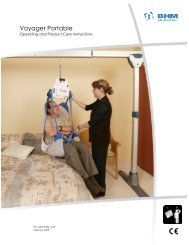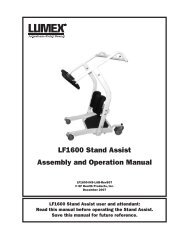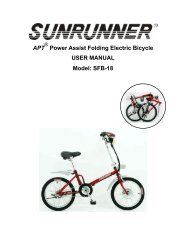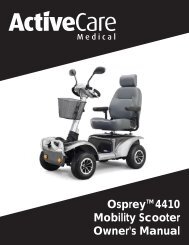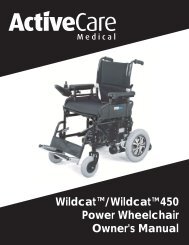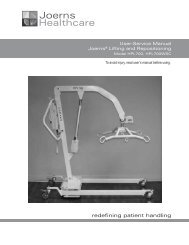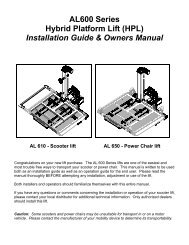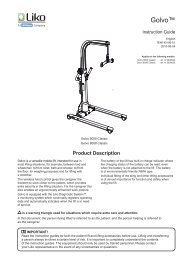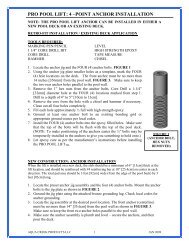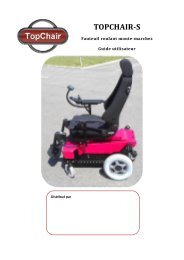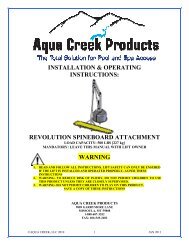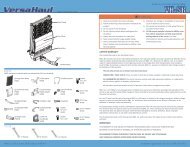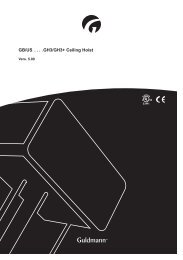lf1030 hydraulic patient lift lf1040 electric patient lift user manual
lf1030 hydraulic patient lift lf1040 electric patient lift user manual
lf1030 hydraulic patient lift lf1040 electric patient lift user manual
You also want an ePaper? Increase the reach of your titles
YUMPU automatically turns print PDFs into web optimized ePapers that Google loves.
Lifting the <strong>patient</strong> from the floor<br />
1. Position the <strong>patient</strong> <strong>lift</strong> behind the <strong>patient</strong>, placing a pillow over the base to protect and support<br />
the <strong>patient</strong>’s head and neck. Place the <strong>patient</strong>'s head carefully on the base. The <strong>patient</strong> <strong>lift</strong><br />
should be positioned with the spreader bar centered over the <strong>patient</strong>.<br />
2. Lower the spreader bar. Attach the sling to the spreader bar hooks.<br />
3. Lift the <strong>patient</strong> up above the floor. Position the <strong>patient</strong> in the sling by pulling the handle on the<br />
back of the sling. Turn the <strong>patient</strong> to face the <strong>lift</strong>ing column, and place the <strong>patient</strong>’s feet on the<br />
base, straddling the column for extra stability.<br />
Lowering the <strong>patient</strong> to the floor<br />
1. Place a pillow on the base to protect the <strong>patient</strong>’s head and neck (this is unnecessary when using<br />
a sling with a head support).<br />
2. Reverse the above procedures to lower.<br />
Transferring the <strong>patient</strong> from a chair to a wheelchair or commode chair<br />
Note: GF Health Products, Inc. recommends that two attendants be used when transferring<br />
a <strong>patient</strong> to and from a wheelchair.<br />
1. Fold the sling.<br />
2. While maintaining support, gently lean the <strong>patient</strong> forward. Place the folded sling behind the<br />
<strong>patient</strong>’s back and push it down until it touches the seat of the chair.<br />
3. Use the loops to pull the leg sections of the sling forward and beneath the <strong>patient</strong>’s thighs.<br />
Then cross the loops, one through the other.<br />
4. Move the <strong>patient</strong> <strong>lift</strong> around to the front of the chair.<br />
5. Hook all sling loops onto the spreader bar.<br />
6. Carefully raise the <strong>patient</strong>.<br />
7. The second attendant should now move the wheelchair into position.<br />
8. Engage the wheelchair wheel locks to prevent movement.<br />
WARNING: Before transfer, ensure wheelchair wheel locks are in locked position. Wheelchair<br />
wheel locks must be in a LOCKED POSITION before lowering the <strong>patient</strong> into the<br />
wheelchair, or unexpected wheelchair movement could result, which may result in serious<br />
injury to both the <strong>patient</strong> and the attendants.<br />
9. Position the <strong>patient</strong> over the wheelchair with their back against the back of the wheelchair.<br />
10. SLOWLY lower the <strong>patient</strong> into the wheelchair.<br />
11. With one attendant behind the wheelchair and the other operating the <strong>lift</strong>, the attendant behind<br />
the chair should pull back on the handle or sides of the sling to place the <strong>patient</strong> into the<br />
back of the chair. This will maintain a good center of balance and prevent the chair from tipping<br />
forward.<br />
LF1030-INS-LAB-RevB10 14



